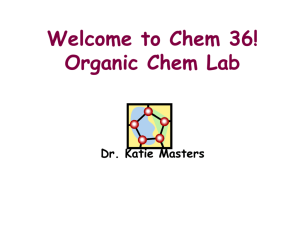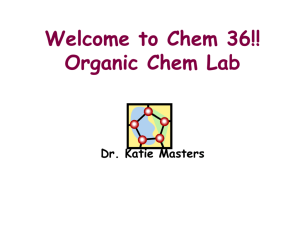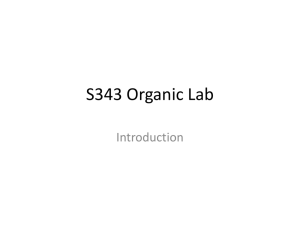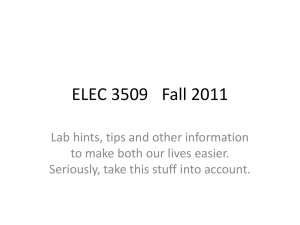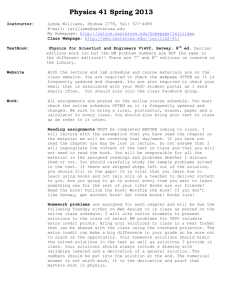ppt file
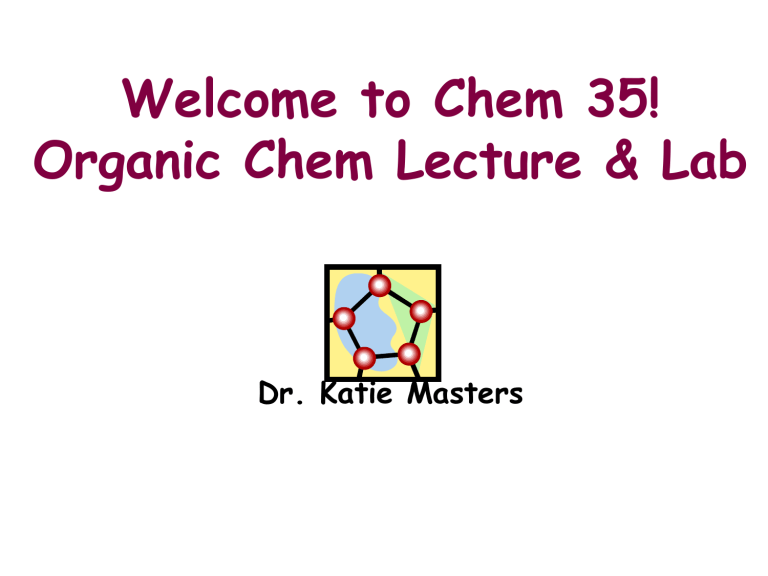
Welcome to Chem 35!
Organic Chem Lecture & Lab
Dr. Katie Masters
Section 1
Section 2
Faculty in
Charge
Office
Hours
Website
Chem 35 Info…
Lecture: Tuesday & Thursday 8:00 - 8:50 am
Lab: Tuesday 9:05 am - 1:10 pm
205/215 Whitmore Lab
Lecture: Tuesday & Thursday 8:00 - 8:50 am
Lab: Thursday 9:05 am - 1:10 pm
205/215 Whitmore Lab
Dr. Katie Masters
Director, Organic Labs
218 Whitmore Lab
Phone: 863-3319 kmasters@psu.edu
Dr. Jackie Bortiatynski
Director, Instrumentation
211D Whitmore Lab
Phone: 865-2772 jackie@chem.psu.edu
Wednesday, 3 to 5 pm http://courses.chem.psu.edu/chem35
Required Materials
Lab Guide for Chemistry 35 & 36B: A Life Science Experience in the
Organic Laboratory Minard, Masters, Halmi, Williamson, Bortiatynski
2007 Edition, Hayden McNeil
Organic Chemistry Laboratory Notebook, R. Minard & K. Masters, Hayden McNeil
Eye Protection Eye Protection is required at all times in lab!
Organic Lab Equipment Kit
Combination or key lock
Lab apron and rubber gloves (optional)
Fundamentals of Organic Chemistry , 6th Edition , J. McMurry, Brooks/Cole
Study Guide/Solutions Manual for Fundamentals of Organic Chemistry, 6th
Edition , Brooks/Cole
Lab Assignments
First Half of Semester:
5 Technique Experiments
• Recrystallization & Melting Point
• Extraction
• Distillation & Boiling Point
• Thin-Layer Chromatography (TLC)
• Column Chromatography
Second Half of Semester:
2 Synthetic Experiments
Assigned based on major; Download from the course website.
Throughout the Semester:
Spectral Unknown Experiment
Determine an unknown’s structure
Assessment: PreLabs (30 pts) and Final Reports (100 pts)
For each experiment you run. Spec Unknown has no PreLab.
Lab Quizzes (50 pts)
Quizzes 1-5
Lecture Assignments
• Reading Assignments
• Assigned Problems (not collected)
• Lecture Problems (collected):
-Given in lecture
-Due the following lecture
-Problems related to lecture, reading, and assigned problems
-Hand in at the beginning of lecture!
-No make ups
-10 total; 10 pts each
•
Lecture Quizzes:
-Quizzes 6, 7, and 8
-50 pts each
Breakdown of the Chem 35 Points
5 Technique Experiment PreLabs
5 Technique Experiment Final Reports
2 Synthetic Experiment Prelabs
2 Synthetic Experiment Final Reports
Spectral Unknown Determination
TA Evaluation
Quizzes
Lecture Problems
Maximum Lab Points
120 points*
400 points*
60 points
200 points
100 points
100 points
400 points
100 points
1480 points
*Chapter 4 PreLab and Final Report do not count towards the final grade. These assignments are NOT an option! Failure to do either assignment will result in a 20 point deduction off your final grade for each missing assignment.
The Lab Experiments: Techniques
Chapter 4: Recrystallization and Melting Point: 1 day lab
Recrystallization & MP of an Unknown
MP of Spectral Unknown (Ch 12 experiment)
Chapter 5: Extraction: 2 day lab
Day 1: Separation of a Solid Mixture (acid/base chemistry)
Day 2: Extraction of Caffeine from Tea or Coffee
Chapter 6: Distillation & BP: 2 day lab
Day 1: Steam Distillation of a Spice
Day 2: Microscale Fractional Distillation of an Unknown Mixture
Work with Fractional & Simple Distillation Data
Technique Experiments
Chapter 7: Thin-Layer Chromatography: 1 day lab
Finding a TLC Mobile Phase
Identifying Compounds in an Analgesic Tablet
Chapter 9: Column Chromatography: 2 day lab
Extraction & Separation of Plant Pigments from Leaves
Chapter 12: Spectral Unknown Experiment: Ongoing lab
Melting point, IR, 1 H NMR, and MS spectra
Determine the structure of an unknown
Synthetic Experiments
Chapter 10: The Synthetic Experiments
• 2 Synthetic Experiments - downloaded from web
• Assigned based on major! New for this semester!
• Up to 20 different experiments in each TA’s section
• Work independently
• Curriculum is a work-in-progress
PreLab Assignments
Purpose of PreLabs & Lab Quizzes: To ensure that each student has read through and understands the procedures of each experiment.
Revised PreLab Format
4 Sections:
1.
Purpose of Experiment
2.
Diagrams of Special Apparatus & Reactions
3.
Chemical Data Table
4.
PreLab Exercise
5.
Chromatographic Behavior & Spectral Features Comparisons (synthetics only)
PreLabs are hand-written into the Lab Notebook. White pages are handed in for grading. The yellow copies are kept in the notebook.
NOTE: Download grade sheets from website!!
PreLab Sections: Purpose of Experiment
• A concise, brief statement (one to two sentences) that describes the purpose of the experiment.
• Never use the first person!
• Do not include set-up of apparatus in this section.
Good Example:
To sublime (purify) an unknown solid and to take a melting point of the purified unknown to determine its identity. To obtain and interpret an 1 H
NMR spectrum of unknown to verify identity.
Bad Example:
I will take a melting point.
PreLab Sections: Diagrams of Special Apparatus and/or
Reaction Equations
Diagrams of Special Apparatus:
• Hand-draw and label any piece of glassware/equipment or reaction set-up that has not been used in previous experiments.
• Please draw neatly!
Reaction Equations:
• Hand drawn.
• You will start including reaction equations with the synthetics.
• Indicate limiting reagent and include the theoretical yield of the product.
O
CH
2
CH
3
Cl
4-chloropropiophenone
Limiting Reagent
Oxidation by KMnO
4 in base, heat for 1/2 hr
O
OH
Cl
4-chlorobenzoic acid
Theoretical yield = 0.67 g
PreLab Sections: Chemical Data Table
1.Common Shelf Chemical Data Table:
• Located in notebook
• Fill out completely and hand in with Chapter 5 PreLab
2.Blank Chemical Data Tables:
• Located in notebook
• Include chemicals for the experiment that do not appear on Common
Shelf Chemical Data Table
• Fill out all information about each chemical (see example in Ch 3).
• Waste disposal information can be found in chapter 2 of the lab guide .
Use the Aldrich Catalog to find information about chemicals. When using
Aldrich, pick the chemical entry that does NOT have isotopic labeling, e.g, d ,
1 5 N , 13 C . These are more expensive and will have different FWs. Aldrich will also tell you if a chemical is flammable or toxic or an irritant.
Typically, use the last entry that gives all necessary data for the table. Use the “least pure” entry for price.
PreLab Sections: Chemical Data Table
There are two different editions of The Aldrich catalog. Please see Chapter 3 for details about your edition!
Columns of the Chemical Data Table:
Chemical Name
Chemical Structure (draw out structure)
Physical state: s (solid) or l (liquid)
BP/MP: If solid, list melting point; if liquid list boiling point (in °C)
Liquid density: in catalog, density is represented by “d”; units in g/mL
Quantity: the amount you’ll use in the procedure (mg, mL, or g)
MW: molecular weight of compound; units in g/mol (given in catalog) mmol: millimole amount; calculate by using the quantity and MW; fill in only for Chapter 8 and 9 experiments
Flammability: if flammable, write “yes”; if not, write “no”; this info given in
Aldrich
Toxicity: if toxic, write “yes”; if not, write “no”; info given in Aldrich
Price: given in Aldrich; give price for 100 g or 100 mL
Waste category: info given in Chapter 2; some categories include HO, NHO, D,
WB, HM
Comment: if compound is an irritant, hydroscopic, corrosive, etc, write it here; info given in Aldrich
PreLab Sections: PreLab Exercise
Answer the three assigned questions located in the lab guide.
Assignment sheet is handed out during check-in.
PreLab Sections: Chromatographic & Spectral
Features Comparisons
For the synthetic experiments only!
Chromatographic Comparison
Relative R f comparison between main organic starting material and main product of reaction.
Example:
OH
(Draw out structures)
Cyclohexanol
Starting material
Cyclohexene
Product
Cyclohexanol would have a lower R f value due to the OH functionality, which is more polar than the alkene of cyclohexene.
PreLab Sections: Chromatographic & Spectral
Features Comparisons
For the synthetic experiments only!
Spectral Features Comparison
Consider diagnostic 1 H NMR & IR signals for the starting material and product that would be used to distinguish the two from one another.
Example:
OH
Diagnostic
Signals
1 H NMR
Diagnostic IR Signals
(Draw out structures)
Cyclohexanol
Starting material
Cyclohexene
Product
Cyclohexanol
OH proton at 2-6 ppm, singlet
O-H stretch (broad) at
3600-3200 cm -1
Cyclohexene
=C-H (alkene) proton at
5-6.5 ppm, quartet or multiplet (due to complex splitting)
1
C=C stretch at 1658 cm -
Lab Quizzes
Purpose: To test your understanding of theory and your preparedness for the experiments.
Quiz 1: Chapter 4
Quiz 2: Chapter 5
Quiz 3: Chapter 6
Quiz 4: Chapter 7
Quiz 5: Chapter 9
Please note schedule for dates of quizzes. They will be given at the beginning of lab and will take 10-15 minutes to complete.
Each is worth 50 points. Graded quizzes are not allowed to leave the lab.
Quizzes 15 will include questions on the specific procedures of the chapters’ experiments and safety considerations.
Sample quiz questions are given in the chapters.
Final Report Assignments
5 Sections:
I.
Introduction
II.
Procedure and Data/Observations
III.
Results/Discussion/Conclusions
IV.
PostLab Exercise
V.
Reference
Attach the white in-lab notebook pages. You must have your TA initial all pages used during each lab session. Attach annotated spectral data when appropriate. Attach grade sheet to the front; download grade sheets from website.
Final reports are computer-generated. Reaction schemes can be hand drawn.
Graded final reports cannot be taken out of the lab (except Ch 4).
Final Report Sections: Introduction
• For the technique experiments (Chapters 4 through 9), include a description of each technique used (there may be more than one), of what the technique is, the theory that makes it work, and why chemists use it. Take care to be concise and to avoid repetition.
• For the synthetic reactions, state the significance of the reaction and/or compound made or isolated. Include a hand-drawn scheme of the reaction mechanism and briefly discuss it.
DO NOT include experimental, procedural detail in the Introduction!!
For instance, do not describe how you add a reagent to a flask or mention the size flask you will use. Do not include specific measurements made. Save this procedural detail for the
Procedure and Data/Observations section of your Final Report.
Final Report Sections: Procedure and Data/Observations
• Paragraph format
• Use your in-lab notebook pages (carbonless copy pages) to write this section
• Type up the procedure and include data and observations when appropriate
General Comments:
• Never start a sentence with a number.
• For synthetic experiments, provide mmol amount with mass amount
• Use leading zeroes: 0.080 g rather than .080 g
• Include units with every measurement
• Use abbreviations where appropriate (g for grams, etc)
• Use the proper number of significant figures
• Old techniques need not be described in detail again
• Use sub-headings as appropriate to organize this section
• Report, but do not analyze data
Final Report Sections: Results/Discussion/Conclusion
Results & Discussion:
• Data analysis
• Introduce the data or calculations before presenting them
• Explain deviations from expected results
• Use grade sheet as a guide!
• Most important section of report!
Conclusions:
• Was the purpose achieved?
• Were the expected results obtained?
• Was the desired product made?
• Did the analysis support/confirm predicted results?
• Do not include new information here.
Final Report Sections: Reference
Referencing the Lab Guide:
Minard, B.; Masters, K. M.; Halmi, T. O.; Williamson, K. L.
Lab Guide for Chemistry 35 & Chemistry 36, 2004-2005, pp. 30-42.
Referencing a Synthetic Experiment Handout: http://courses.chem.psu.edu/chem36, “Oxidation of Borenol to
Camphor, Experiment 125”
Final Report Sections
New for this edition:
Each experiment/chapter (Chapters 4 through 10) has detailed “consideration lists” for each section of a final report that will help guide you through writing the Final Reports for these experiments!
Thanks to Denise Conner, a former Chem 35 TA.
For example in Chapter 4, Recrystallization Introduction Section (page 118),
Items to consider:
• What is recrystallization, physically?
• How/why does recrystallization work?
• What constitutes a good solvent?
• What is recrystallization good for? Why do chemists use it?
• What does melting point reveal about a compound?
• What factors affect melting point? How?
• How would recrystallizing a compound affect its melting point?
• What were the main activities of this chapter’s experiment?
TAs will use these lists as a guide when grading.
Lab Assignments: PreLabs and Final Reports
• PreLabs must be handed in BEFORE running the experiment. Please write them neatly!
• Late work is subject to a 10-point deduction the first day late and a 5-point deduction each additional day.
• See Chapter 3 (Lab Guide) for complete details on PreLabs and Final Reports.
• Course website will have new examples of final reports very soon.
• Grade sheets are to be attached to the front of the PreLabs and Final
Reports; use them as a guide to include all important sections. PreLab and
Final Report grade sheets are on the web.
• Graded final reports and quizzes are not to be taken out of the lab.
They will be kept in a secure location until the end of the semester when they will be shredded.
Important Safety Rules
• Always wear eye protection when in the lab!
• Use gloves when appropriate; wash hands often.
• All chemistry must be done in the fume hoods.
• Your TA must be present when you are in the lab.
• If you wear shorts that are above the knee, you must wear a lab apron.
• No bare midriffs or open-toed sandals.
• Report accidents immediately to your TA.
• Keep coats and book bags on the shelves above your desk - keep them out of the aisles!
Courtesy in the Lab
• Return all reagent and solvent bottles to their proper place on the side
Shelves or in the refrigerator immediately!
• Keep your area clean. Your TA will assign one person to do a general lab clean-up after each lab session.
• Show up prepared and on time.
• Keep the Instrument Room clean (room 206 Whitmore).
• Avoid floods.
• Keep balances clean!
• Treat everyone with respect.
Instrument Room
• NMR Spectrometer
• IR
• UV/Vis
• RI (refractive index)
• Polarimeter
• GC
• GC-MS
Chem 35 & 36 TAs will hold their office hours in this room.
Instrument Room hours will be posted on the door.
Hours:
M, W, F: 1:30 pm - 5 pm
T, R: 9 am - 9:45 pm
**You are required to get all spectra signed and dated by a TA in the
Instrument Room as soon as you acquire them.**
Check-In
• Look for sheets posted by the doors to 205 & 215 Whitmore - they contain all students’ desk assignments and your TA’s name. TA sections are organized by major.
• If your name isn’t on the list and you are registered, wait by the Stockroom and I will place you at an empty desk.
